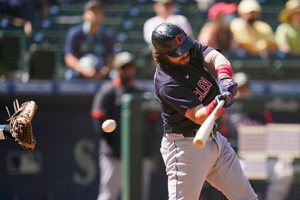 It's the first time baseball had six no-hit games before June, and the season-long record is eight, set in 1884. It's not an issue of unprecedented skill. Mr. Turnbull had the distinction only two years ago of being the Major Leagues' losingest pitcher that season, with 17 losses. His turnaround, dramatic in its own right, reflects a bigger issue for baseball: Strikeouts are way up, batting averages are down, and it's bad for business. It's the first time baseball had six no-hit games before June, and the season-long record is eight, set in 1884. It's not an issue of unprecedented skill. Mr. Turnbull had the distinction only two years ago of being the Major Leagues' losingest pitcher that season, with 17 losses. His turnaround, dramatic in its own right, reflects a bigger issue for baseball: Strikeouts are way up, batting averages are down, and it's bad for business.
In Mr. Turnbull's historic game, the losers struck out nine times, but the winning Tigers struck out 12 times themselves. That same night the San Francisco Giants beat the Cincinnati Reds despite striking out 17 times, while the Tampa Bay Rays and Baltimore Orioles combined for 27 strikeouts, and the Colorado Rockies and San Diego Padres totaled 29. The Atlanta Braves had a rough night, striking out 15 times against the New York Mets, so you'd think the team's ace, Jacob deGrom, who has recorded 65 strikeouts this season, must have been on the mound. No, the Mets did it with an army of seven other pitchers.
The reasons for the pitching surge are numerous but clear. Pitchers are better conditioned and stronger, to the point that 100-mile-an-hour fastballs are common. They are also pitching fewer innings a game—relief pitchers often take over after only five or six innings—meaning they can throw as hard as possible without worrying about pacing themselves.
Hitters, meanwhile, have embraced a new approach—uppercutting to hit fly balls. This produces more home runs, but also more strikeouts. And even if hitters manage to make contact, they are facing exotic defensive shifts, steered by complex computer algorithms that take into account everything a batter has ever done, short of what he had for breakfast.
"I watched a game the other night, the first three innings the ball wasn't put in play by either team," Houston Astros manager Dusty Baker told ESPN. "Everyone struck out. I've never seen that."
A lack of hitting can make for dull games, and an abundance of strikeouts elongates contests with more pitches. So baseball is experimenting with all sorts of corrections in the minor leagues. At the Double-A level this season, all infielders must have their feet on the infield dirt when a pitch is thrown, stopping defenders from shifting to the outfield.
Starting Aug. 3, in an experiment conducted at the behest of the major leagues, the independent Atlantic League will move the pitching rubber back 12 inches to 61 feet, 6 inches, giving hitters more time to react.
I think pitching duels are often exciting. Too bad baseball's leaders fiddle with the rules every time the game's momentum shifts.
(c) Peter Funt. This column originally appeared in The Wall Street Journal.
|
|



 It's the first time baseball had six no-hit games before June, and the season-long record is eight, set in 1884. It's not an issue of unprecedented skill. Mr. Turnbull had the distinction only two years ago of being the Major Leagues' losingest pitcher that season, with 17 losses. His turnaround, dramatic in its own right, reflects a bigger issue for baseball: Strikeouts are way up, batting averages are down, and it's bad for business.
It's the first time baseball had six no-hit games before June, and the season-long record is eight, set in 1884. It's not an issue of unprecedented skill. Mr. Turnbull had the distinction only two years ago of being the Major Leagues' losingest pitcher that season, with 17 losses. His turnaround, dramatic in its own right, reflects a bigger issue for baseball: Strikeouts are way up, batting averages are down, and it's bad for business.